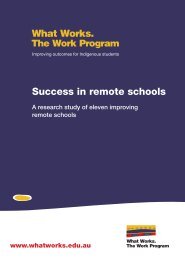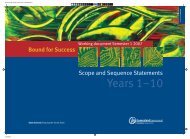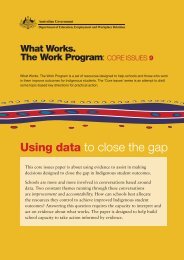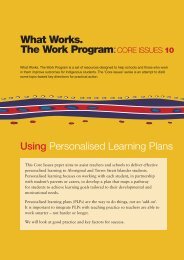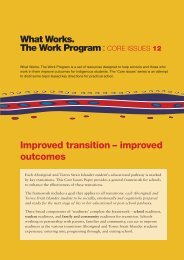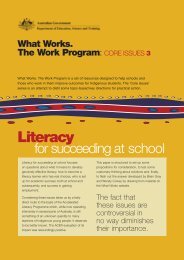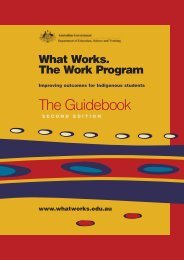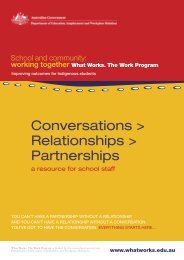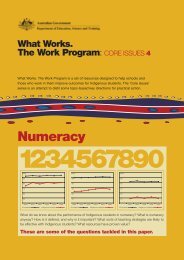Indigenous education: International perspectives - What Works
Indigenous education: International perspectives - What Works
Indigenous education: International perspectives - What Works
You also want an ePaper? Increase the reach of your titles
YUMPU automatically turns print PDFs into web optimized ePapers that Google loves.
Emery’s list<br />
Here are ten things I recommend to those tasked<br />
with improving <strong>education</strong>al quality.<br />
1. Create an ongoing conversation about student<br />
achievement.<br />
2. Build on a sound, high quality core curriculum.<br />
3. Provide teachers with assessment tools that help<br />
them understand how well each student meets<br />
the learning outcomes of the curriculum.<br />
4. Develop high quality leadership. From the<br />
classroom to the national level leaders must<br />
understand the importance of high achievement<br />
for all, advocate for it and have the skills to<br />
create, manage and monitor strategies to<br />
make it happen.<br />
5. Establish a culture of urgency and responsibility.<br />
Make failure of any child unacceptable.<br />
6. Accept no excuses for low student achievement.<br />
7. Ensure that teacher training prepares teachers<br />
to help students achieve at high levels.<br />
8. When evidence shows results are unacceptable,<br />
take action on behalf of students.<br />
9. Help educators close the gap between knowing<br />
about poor achievement and correcting it.<br />
We must learn how to improve achievement<br />
for each student.<br />
10. Ask schools to build improvement plans from the<br />
plans for individual students. This keeps student<br />
achievement at the centre of planning and<br />
decision-making.<br />
In support of the recommendations, following are<br />
five data lessons that I believe are applicable to<br />
most <strong>education</strong> jurisdictions.<br />
• Questions precede data. [See the list of<br />
five questions in the excerpts from his address,<br />
page 15.]<br />
• Collect data at individual level.<br />
• Track each student’s achievement throughout<br />
their school lives.<br />
• Make data available to the people most affected.<br />
• Embed data use in improvement systems.<br />
Reasons for hope<br />
— Excerpts from a presentation from Tony Greer,<br />
Group Manager, <strong>Indigenous</strong> and Transitions Group,<br />
Department of Education, Science and Training.<br />
Amid the unceasing effort, there are signs<br />
of progress which are cause for celebration,<br />
publicity, and subsequent investigation as to the<br />
generalisability of the procedures or programmes<br />
and the social constructs which underlie them.<br />
Three brief examples will have to suffice as<br />
indicators of such successes.<br />
First, a manifest cause for celebration.<br />
Elaine Morganson’s story is an inspiring one, of<br />
commitment and dedication. Now a Year 8 teacher<br />
at Abergowrie College in Queensland, her life at the<br />
school began almost 30 years ago, when she applied<br />
for a job doing domestic duties. She worked in the<br />
laundry until 1994, and then worked as the college<br />
cook until 1999 when her excellent rapport with the<br />
college’s students was recognised and a colleague<br />
suggested she apply for teacher’s aide work. After<br />
successfully applying for a scholarship to the<br />
Australian Catholic University, Ms Morganson<br />
began six years of study by correspondence.<br />
In April 2007, she graduated from the university<br />
as a Bachelor of Education, and is now teaching<br />
a Year 8 class at the college, having started as a<br />
teacher half way through 2006.<br />
Second, a case deserving wide publicity; a success<br />
appearing at the level of an individual institution.<br />
Woolaning Homeland Christian College is a<br />
secondary boarding school south of Darwin in the<br />
Northern Territory in an area which is one of the<br />
poorest in the country. The college began with the<br />
seed of an idea about how to get local students to<br />
secondary school without having to send them to<br />
Darwin where they would be prey to drugs and<br />
alcohol.<br />
The Principal says that the programme starts from<br />
the understanding of the hardships most students<br />
share. When the students come to the school from<br />
the community, they will be 13 to 15 years old<br />
having led community lives often typified by social<br />
dysfunction and indeed tragedy. They will typically<br />
have the literacy levels of Years 1 and 2: when they<br />
start most don’t know the alphabet. He says: ‘It’s not<br />
because they are deficient; it’s because they have not<br />
had the consistent schooling.’<br />
17



